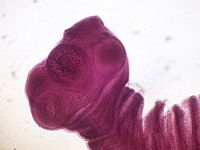
Photo from wikipedia
A 31-year-old man presented with a 3-week history of a migratory, itching rash with blisters on his right foot. He reported walking barefoot on the sand during a trip to… Click to show full abstract
A 31-year-old man presented with a 3-week history of a migratory, itching rash with blisters on his right foot. He reported walking barefoot on the sand during a trip to the Brazilian coasts some weeks before. Physical examination showed serpiginous erythematous papules on the foot with bullous lesions and serum oozing erosions suggestive of cutaneous larva migrans (CLM) (Figure 1). Dermoscopy revealed erythematous linear track with some erosions and yellowish vesicles. Reflectance confocal microscopy (RCM, VivaScope 3000, Caliber, USA) confirmed the presence of a hyporeflective disruption in the normal honeycomb pattern of the epidermis corresponding to the larval burrow (Figure 2A and B). In some areas, it was possible to observe hyporeflective oval areas corresponding to vesicles withmany small hyperreflective point structures corresponding to inflammatory
Journal Title: Skin Research and Technology
Year Published: 2021
Link to full text (if available)
Share on Social Media: Sign Up to like & get
recommendations!